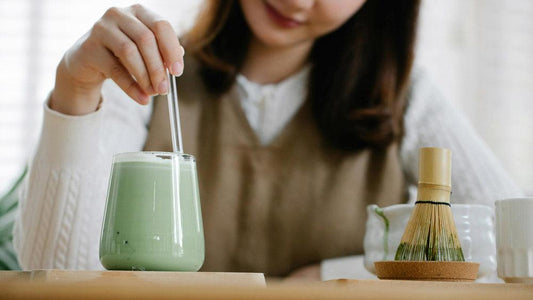
Matcha cultivar: the secret of taste
Sébastien GELLESummarize the article with:
You've noticed, haven't you? Almost all matchas proudly display "Ceremonial Grade" or "Superior Quality" on their packaging. But when you taste them, some are smooth and creamy, others bitter and astringent. Some radiate an electric green, others lean towards yellow.
The real secret of a great matcha is not hidden behind these marketing terms. It lies in its cultivar .
Summary
- What exactly is a matcha cultivar?
- The impact of the cultivar on your matcha (taste, color, umami)
- The 5 main matcha cultivars you should know
- Matcha "Single Cultivar" vs. "Blend" (blend): which to choose?
- How to choose your matcha according to the cultivar?
- The matcha cultivar, a true indicator of taste
What exactly is a matcha cultivar?
Imagine you're choosing a wine. You'd never simply say "a good quality red," would you? You'd look for the grape variety: Pinot Noir, Merlot, Cabernet…
The cultivar is exactly the same for matcha. It's the specific botanical variety of the tea plant (Camellia sinensis) from which the leaves are derived. Just as a Pinot Noir doesn't taste like a Merlot, a Saemidori doesn't taste like a Yabukita.
Think of it like apple varieties: a Granny Smith is crisp and tangy, a Golden Delicious is sweet and melting. Same principle. The cultivar determines everything: the taste, the color, the texture, the intensity of the umami.
And it is precisely this information that you need to know in order to move from the status of consumer to that of connoisseur .
The impact of the cultivar on your matcha (taste, color, umami)
You may have wondered why some matchas envelop you in a creamy sweetness while others leave that persistent bitterness in the mouth? The answer lies in the genetics of the cultivar.
Taste: a matter of natural chemistry
Some cultivars are naturally rich in L-theanine – the amino acid that creates that sought-after umami flavor, that almost sweet, velvety smoothness. Others produce more catechins, responsible for bitterness and astringency.
It's not a question of quality. It's a question of profile. Gokô, for example, is renowned for its deep, almost oceanic umami. Yabukita, on the other hand, offers a more classic balance with pronounced vegetal notes and a refreshingly light bitterness.
Color: more than just a matter of aesthetics
That vibrant green that brightens your bowl in the morning? It's directly related to the cultivar.
Saemidori, for example, is famous for its electric, almost fluorescent green, which instantly gives an impression of vitality. Gokô, on the other hand, sports a deeper, more mysterious green.
This color is not just beautiful to look at, it testifies to the concentration of chlorophyll and the health of the leaves.
The texture: the magic of mousse
The ability to create that smooth, persistent foam? Once again, the cultivar plays a role. Some are naturally creamier, others lighter. It's this alchemy that makes a matcha caress your palate or simply pass through it.
The 5 main matcha cultivars you should know
Here are the stars of the matcha world, the ones you absolutely must know to refine your choices and preferences.
| Cultivar | Dominant Taste Profile | Color | Ideal for… |
|---|---|---|---|
| Yabukita | Balanced, fresh vegetal notes, slight bitterness | Standard green | Assemblies, everyday use, initial discoveries |
| Saemidori | Very mild, subtle umami, almost no bitterness | Very bright, “electric” green | Ceremony (Usucha), pure tasting, moments of meditation |
| Gokô | Deep, rich umami, marine notes, enveloping sweetness | Deep green | Ceremony (Koicha), lovers of intense umami |
| Okumidori | Harmonious, delicate floral notes, perfect balance | Bright green | Ceremony (Usucha), premium blends |
| Asahi | Intense umami, aromatic complexity, elegance | Bright green | Special occasions, contemplative tasting |
Yabukita: the versatile prop
This is the most widely cultivated tea variety in Japan (accounting for approximately 75% of tea production). Why? Because it's resilient , with excellent resistance to frost and disease. But don't be fooled: this isn't a "basic" variety. It offers a balanced profile, with pronounced vegetal notes and a slightly invigorating bitterness. It forms the basis of many high-quality blends and makes an excellent everyday matcha .
Saemidori: luminous softness
If you're looking for a matcha that transports you to a haven of tranquility , this is it. Saemidori is renowned for its subtle and delicate umami , its near absence of bitterness, and its vibrant green color that brightens your bowl. It's the perfect cultivar for zen mornings and mindful rituals. More delicate to cultivate than Yabukita, it requires more attention.
Gokô: Noble Intensity
Gokô is the cultivar for umami enthusiasts . Its profile is deep, almost marine, with a richness that lingers on the palate. It's a matcha for contemplation, ideal for a thick and creamy koicha, or for those moments when you truly want to sit back and savor every sip. It's the grand cru of matcha.
Okumidori: floral harmony
Okumidori is the epitome of balance. Neither too bitter nor too sweet, with floral notes that add complexity without ever being overpowering. Its color is vibrant, its foam generous. It's the cultivar of choice for premium blends and elegant ceremonies.
Asahi: precious rarity
Less common, Asahi is prized for its intense umami and aromatic complexity . It's a noble cultivar , often reserved for limited production and special occasions. If you come across it, try it. It's an experience.
Matcha "Single Cultivar" vs. "Blend" (blend): which to choose?
This question comes up often, and it deserves attention. Because no, an assembly is not of inferior quality . It's simply a different philosophy.
The Blend (mixture): consistency and harmony
Think of non-vintage champagne, or your signature perfume that always smells the same. Blending aims for consistency . The master blender (yes, it's a real profession!) combines several cultivars to create a harmonious, signature flavor profile that remains stable throughout the year, regardless of harvest variations.
This is the art of composition : taking the best of each cultivar (the sweetness of Saemidori, the structure of Yabukita, the richness of Gokô) to create something greater than the sum of its parts.
The Single Cultivar (monovarietal): character and typicity
Conversely, single-cultivar wines are the pure expression of a single variety and a single terroir . They are more refined, more distinctive. They represent estate wines, single-origin chocolate, and producer-quality olive oil.
The goal isn't consistency, but character . You taste the Saemidori in all its radiant sweetness. You explore the Gokô in all its marine depth. It's a unique tasting experience, often more pronounced, sometimes more surprising.
How to choose your matcha according to the cultivar?
Now that you know the main cultivars, here's how to refine your choice according to your desires and your moments.
If you're looking for maximum umami and richness…
Opt for Gokô or Asahi . These premium cultivars are perfect for a thick and creamy Koicha, or for those mornings when you crave a deep and comforting matcha. It's the matcha for cozy Sundays.
If you want a very mild, vibrant matcha without any bitterness…
Try Saemidori . It's the matcha for gentle rituals, ethereal Usucha, and moments of meditation. If you're sensitive to bitterness or looking for something refined and luminous, this is the cultivar for you.
If you're looking for an excellent, balanced, everyday matcha…
A Yabukita-based blend is a safe bet . You'll get that vegetal structure, that balance between sweetness and freshness, that reliability that makes it work just as well in your morning latte as in your afternoon bowl.
If you want to explore and refine your palate…
Opt for a tasting of single cultivars . Try a Saemidori one day, an Okumidori the next. Note the differences. That's how you truly learn about matcha and discover what you like.
The matcha cultivar, a true indicator of taste
You now know that the cultivar is the true indicator of taste , much more so than the "grade" or marketing promises.
The next time you buy matcha, ask the question: what is the cultivar? If the brand cannot answer you, it may be a sign that they don't really know their product.
Now you know. And that changes everything.
Discover our Ceremony Single Origin Matcha.



